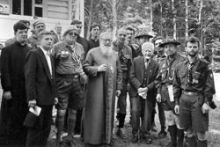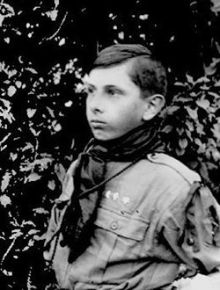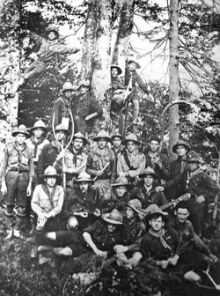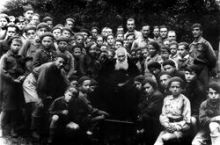In 2012 the Ukrainian Plast will be one hundred years old. It was born from a strong need for a youth organization to serve the Ukrainian people. Taking the international scouting movement as a basis, the founder of Plast Oleksandr Tysovsky elaborated a unique educational system. Despite being similar to the scouts, it has a number of specific features. In particular, the three main duties of a Plast member: loyalty to God and Ukraine, helping others, and living in compliance with the Plast code and obeying the Plast leadership.
The background of this organization can be divided into several stages, most of which coincide with important milestones in Ukrainian history. The period from 1912 up to the 1920s are its first years of activity. At the beginning of the First World War many Plast members joined the Sich Riflemen. In the 1920s-1930s, after the defeat of the Ukrainian People’s Republic, Plast was renewed in western Ukraine, and later among the diaspora. During the following decade it was considered to be illegal. In the period from 1945 to 1989 Plast actively operated in countries of North and South America, in Australia, Britain, France, and Germany – the places with the highest concentrations of Ukrainians. Since the 1990s it has functioned in independent Ukraine.
Being a university student, I became a Plast member myself. After the pioneers and Komsomol (the Young Communist League), life in Plast was as a gulp of fresh air. Natural. Built on human foundations common to the mankind and Ukrainians. Adventurous in a youthful way. And with a rich history: Roman Shukhevych, Stepan Bandera, the Ukrainian Insurgent Army (UPA) commander (after the death of Roman Shukhevych) Vasyl Kuk, the poets Oleh Olzhych and Ivan Irliavsky, the human rights activist Nadia Svitlychna, and historian Orest Subtelny. Among our contemporaries prominent Plast members are the head of the Ukrainian Greek Catholic Church Liubomyr Huzar, economist Bohdan Havrylyshyn, poetess Vira Vovk, the first US ambassador to Ukraine Roman Popadiuk. And though Dmytro Dontsov, Olena Teliha, Avhustyn Voloshyn, Andrii Melnyk, Andrey Sheptytsky, and patriarch Mstyslav didn’t belong to Plast directly, they nevertheless cooperated closely with it. The Day talks about the past and the present of the organization with the television journalist of the First National television channel Oleh KLYMCHUK, who has been working on a documentary about Plast.
“We somehow reached an agreement right away that the movie dedicated to the centennial of Plast shouldn’t be of the historical-newsreel variety,” says Oleh. “Instead, it will be based on a few interesting, even perilous fates of real people. Who precisely is still a secret of the screenplay. I just want to say that, as it is known, Plast counts many prominent and even historical figures amongst its ranks, so it wasn’t easy to select the protagonists. Thus, we want to focus on how important Plast was for Ukraine throughout the century, what role it played in our history. By the way, during the presidency of Viktor Yushchenko there was even a resolution on creating such a movie. However, as it often happens, it remained on paper. The shooting of the movie is financed by private donors.”
Will it deal with the modern history of the organization as well?
“Obviously. But not about what the organization will become in the future. Hopefully, it will continue being influential and reputable. Surely, some priorities will change, but the main values of Plast remain the same: loyalty to God and Ukraine, our community, and Plast leaders.”
As far as I know, you’re the author of the screenplay. And who is the director? Generally, who is in your team?
“I won’t name the director yet. I’ll just say that we’ve been acquainted since we worked together at one of popular television channels. We involve the press department of the Plast management in Kyiv in the preparation and creation of the material, and also local and foreign archives. We have many people who gather documents and facts about the history of the organization. They record recollections. There is even a real museum-archive of the history of Plast.
“Today we’re at the stage of accumulating material. Last summer we shot some fragments. We also have a few valuable emigration archives from the 1950s and 1960s. Lots of amateur video from the 1990s. Besides, my colleagues interview Plast veterans who are 80 years old and more. Unfortunately, they are passing away, as we say in Plast, ‘to the eternal bonfire.’ Their valuable recollections, which often encompass a few periods of our past, this is an oral history. In particular, we have vivid, adventurous accounts from our heroes about the 1920s-1930s: in what conditions Plast existed then, how it had to go underground, first because of Polish oppression and then the Soviet government. Often the fates of Plast members could potentially become plots for Ukrainian movies – documentaries or features. We hope to get an agreement for conversations with relatives of famous past activists of the Plast movement, especially martyr Father Roman Lysko, murdered by the NKVD (it is even unknown where he was buried). Or with relatives of one of the most prominent commanders of the Ukrainian Insurgent Army, colonel, commander of the detachment ‘Black Wood’ UPA-West Vasyl Andrusiak. Or with Petro Halushchak, who is a relative to Petro Franko, who together with Tysovsky laid the foundations of Plast. We also plan a serious yet friendly conversation with economist Bohdan Havrylyshyn and His Beatitude Liubomyr Huzar.”
And finally: when and where can one watch the movie?
“I hope the movie will be shown on The Day of the jubilee, that is on April 12, 2012. The movie has been created in a format so that it will be possible to show it not only on television, but in cinemas as well. First we thought it would last 55 minutes. But now it becomes clear that it will consist of two interesting parts, 55 minutes each. The history of Plast, as well as the history of Ukraine, can be studied at length.”
TO THE POINT
The All-Ukrainian Plast initiative “Let’s learn history together!” started in the city of Ivano-Frankivsk. As UNIAN reports, on May 12 in the downtown in Nezalezhnosti street, famous Ivano-Frankivsk residents together with Plast members assembled a big puzzle with the image of Ukrainian soldiers of different centuries. Besides Plast members, writers Yurii Andrukhovych, Taras Prokhasko the founder of Perkalaba, Yarema Stetsyk, and musicians of the bands Flit, Khvyliu trymai and Korali assembled a few-meter large mosaic out of over 130 shaped parts.
The participants encouraged pedestrians to take part in the activity, and distributed leaflets. Children were especially interested; they gladly joined the process of assembling the mosaic. The purpose of the activity was to create a game to interest ordinary pedestrians and children in studying the Ukrainian history, especially the glorious Ukrainian military traditions.
For the illustration of the big mosaic the following images were used: warriors of Kyivan Rus, the Zaporozhian Sich, Carpathian Opryshkos, the Sich Riflemen, warriors of the Ukrainian People’s Republic, the Ukrainian Galician Army, Carpathian Sich, soldiers of the Soviet and the Ukrainian Insurgent Army. In order to instruct children all the captions were accompanied with dates. This puzzle will travel to other regional centers and cities of Ukraine where Plast functions.










